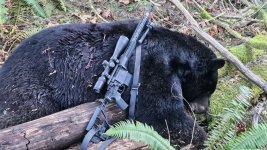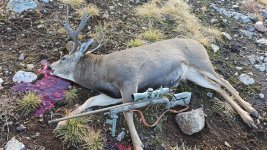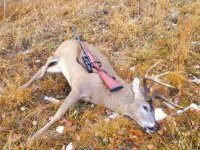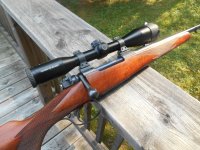No scope can gather light. No scope has 100 percent light transmission. Glass quality and lens coatings are what determines light transmission. Ninety percent and higher light transmission is excellent and over 95 percent is the best optics in the world and its gonna cost $4K and higher.
You are using an out of date browser. It may not display this or other websites correctly.
You should upgrade or use an alternative browser.
You should upgrade or use an alternative browser.
When did scopes get so large?
- Thread starter Marlin989
- Start date
TheMinusHuman
CGN Regular
- Location
- Chilliwack BC
Ya i use bigger scopes for hunting and LR stuff. On my hunting rifle I have a nightforce SHV F1 4-14 and it weighs 30 oz, also have a Browning with a vortex strike eagle 3-18 and it weighs 27.3 oz. I just bought an arken and it's my lightest scope at 23 oz.
Attachments
At what ranges do you hunt? I'm curious to know if you use larger scopes because you will take regularly take long range shots.Ya i use bigger scopes for hunting and LR stuff. On my hunting rifle I have a nightforce SHV F1 4-14 and it weighs 30 oz, also have a Browning with a vortex strike eagle 3-18 and it weighs 27.3 oz. I just bought an arken and it's my lightest scope at 23 oz.
Cheers,
Marlin989
TheMinusHuman
CGN Regular
- Location
- Chilliwack BC
I shot that bear at 300 yards even, the longest shot I'd feel comfortable taking is about 400 yards. I'm usually shooting critters 200 and in though. I like to use my hunting rifles out to 1000 on steel though, thus their tacti-cool look.At what ranges do you hunt? I'm curious to know if you use larger scopes because you will take regularly take long range shots.
Cheers,
Marlin989
- Location
- Nova Scotia
Just face it, everything got bigger. People no longer want compact cars, they want SUVs. Even my 8 year Corolla is 2x the size as my 1998. Houses gotten bigger. My house from the 50s and the counters are short. Even at 5'9 I'm hunching over to use the counters and make supper. Doing the dishes sucks. The oven sits 2inch higher.At what ranges do you hunt? I'm curious to know if you use larger scopes because you will take regularly take long range shots.
Cheers,
Marlin989
No longer have to settle for small optics.
I just wish that someone would actually dismantle high end scopes and review the mechanical properties of rifle scopes...the way they strip down high end engines and show me what makes one superior to another.
There is a lot of talk about optical qualities and image clarity etc etc but unless the scope is mechanically robust ...and the reticle remains repeatable ... all the fine chromatic free and distortion free 'high light transmission' qualities do is give you a better image of the target you just missed.
How many of these guys actually mount the test scope in a rock steady stable bedding block and wack it with a rubber hammer to simulate recoil and then check reticle shift ... or wind the E and W knobs back and forth to see how well they return to a 'zero' when mounted in the same block while also simulating recoil??
For target shooters .. where the vast majority of rounds are expended ... I guess its what ever gives you the confidence and the results you are looking for. ... I listen to a photography podcast related to film and those guys have coined the phrase "Gear Acquisition Syndrome" (GAS) which really apples to us shooters.
I envy guys with high end quality optics... but as I get older and less frequently get out to hunt.. ... when I do, I notice how much nicer a light rifle is and how significantly the weight of scope can effect the balance of a rifle ... and periodically I remind myself the largest white tail I shot (not what most would consider a 'trophy by any means) ... was shot over open sights with a very quick snap shot as he tried to sneak over a ridge about 50 yards away.
There is a lot of talk about optical qualities and image clarity etc etc but unless the scope is mechanically robust ...and the reticle remains repeatable ... all the fine chromatic free and distortion free 'high light transmission' qualities do is give you a better image of the target you just missed.
How many of these guys actually mount the test scope in a rock steady stable bedding block and wack it with a rubber hammer to simulate recoil and then check reticle shift ... or wind the E and W knobs back and forth to see how well they return to a 'zero' when mounted in the same block while also simulating recoil??
For target shooters .. where the vast majority of rounds are expended ... I guess its what ever gives you the confidence and the results you are looking for. ... I listen to a photography podcast related to film and those guys have coined the phrase "Gear Acquisition Syndrome" (GAS) which really apples to us shooters.
I envy guys with high end quality optics... but as I get older and less frequently get out to hunt.. ... when I do, I notice how much nicer a light rifle is and how significantly the weight of scope can effect the balance of a rifle ... and periodically I remind myself the largest white tail I shot (not what most would consider a 'trophy by any means) ... was shot over open sights with a very quick snap shot as he tried to sneak over a ridge about 50 yards away.
- Location
- Saskatchewan
One factor that I didn't notice anyone mention is that the most innovative and highest quality scope manufacturers are from Europe. Germany and Austria mostly. The Europeans are obsessed with precision and quality, unlike the standard USA and Chinese manufacturing method of "just good enough and as cheap as possible" . Europeans tend to build stuff without compromise. And one of the practical laws of optics is that tiny optics provide a poorer image quality than larger optics.
Europeans do a lot of target shooting, and their hunting is somewhat different than ours. There is no downside to big optics on a precision target rifle. So the Europeans make big target scopes. AND Europeans also tend to hunt a lot of big game, especially wild boar, at night. Really big scopes with big objective lenses set on low power work very well for that.
They don't make a lot of good light stalking scopes by comparison.
Europeans do a lot of target shooting, and their hunting is somewhat different than ours. There is no downside to big optics on a precision target rifle. So the Europeans make big target scopes. AND Europeans also tend to hunt a lot of big game, especially wild boar, at night. Really big scopes with big objective lenses set on low power work very well for that.
They don't make a lot of good light stalking scopes by comparison.
there are still many name-brand scopes out there with a single spring guiding the internals against the adjusters, #1 fail point imoThere is a lot of talk about optical qualities and image clarity etc etc but unless the scope is mechanically robust ...and the reticle remains repeatable ... all the fine chromatic free and distortion free 'high light transmission' qualities do is give you a better image of the target you just missed.
Why have they gotten bigger? 1 cents worth is that part of it is material technology improvements. We can make a 4-32x scope that fits on rifle, yes it's heavy but 50 years ago it doesn't seem like it was possible. Just like cameras have gotten smaller and zoom lenses on cameras have gotten bigger in magnification range (the camera that is a portion of your cellphone now that fits in your pocket would have required a backpack of its own to fit the camera and video camera and tapes and zoom lenses).
Why do we buy them? Because we are gear junkies consumers (generalizing) who like the biggest and the newest? -- Maybe and sometimes. Optics in general come down to your use case. Find what you want your tool to do and then find what you think is the best thing for it. Why are their extended cabs and crew cabs and 5-8ft bed on pickups? Because each person has their own use case and budget and for now I can get what I think is best for me.
Enjoy the options and many things just go in circles and cycles and while the optics get bigger and heavier the smaller ones also get better and cheaper (for what you are getting, inflation/rising costs are a different discussion)
Why do we buy them? Because we are gear junkies consumers (generalizing) who like the biggest and the newest? -- Maybe and sometimes. Optics in general come down to your use case. Find what you want your tool to do and then find what you think is the best thing for it. Why are their extended cabs and crew cabs and 5-8ft bed on pickups? Because each person has their own use case and budget and for now I can get what I think is best for me.
Enjoy the options and many things just go in circles and cycles and while the optics get bigger and heavier the smaller ones also get better and cheaper (for what you are getting, inflation/rising costs are a different discussion)
___Exactly. Most guys don’t even really need a scope for what they’re doing with their rifles. Even if it’s on a low level, a lot of guys just want to spend whatever the cost to associate with the guys who do it.
A Tasco pronghorn 3-9x40 is on sale at princess auto for 69.99. If you want to spend more than that you need to decide if it’s worth it to you for the number of hours you will spend behind it and for most it will be.
If a guy were putting together a rifle that he knew he was never going to actually use maybe the tasco is the best route
If you are suggesting a 70 dollar Tasco, one has to wonder if you have ever done much hunting at all?
Almost every style, if not all styles, of hunting benefit from low light transmission, durability, and ability to maintain zero.
Even if you do nothing buy roll around in your truck in perfect daylight conditions, if you somehow manage to see animals you will at the very least need the final option.
Increase your budget if you feel you need more modern accommodations like adjustable parallax, bullet drop compensation reticules or turrets that can be reliably reset and dialed in the field.
Even as a young fudd who mostly owns one inch scopes and "sets it and forgets it" reliable tracking and optical clarity offer literally no downsides in the field.
In my early 20s I used irons and cheap Bushnell and vortex scopes. In my late 20s I switched to mid range brands like leopold, Japanese and European glass have ruined me in my mid 30s, but I still know that at least a mid range brand like leopold or burris offers nothing but advantages for something that can literally last a hunters lifetime.
Spending 250 bucks on a used redfield instead of 70 on a Tasco takes you from borderline useless to "good" light gathering and enough repeatability to last a lifetime of 3 rounds at a pizza box and 2 at a deers ass from the hood of a truck
Almost every style, if not all styles, of hunting benefit from low light transmission, durability, and ability to maintain zero.
Even if you do nothing buy roll around in your truck in perfect daylight conditions, if you somehow manage to see animals you will at the very least need the final option.
Increase your budget if you feel you need more modern accommodations like adjustable parallax, bullet drop compensation reticules or turrets that can be reliably reset and dialed in the field.
Even as a young fudd who mostly owns one inch scopes and "sets it and forgets it" reliable tracking and optical clarity offer literally no downsides in the field.
In my early 20s I used irons and cheap Bushnell and vortex scopes. In my late 20s I switched to mid range brands like leopold, Japanese and European glass have ruined me in my mid 30s, but I still know that at least a mid range brand like leopold or burris offers nothing but advantages for something that can literally last a hunters lifetime.
Spending 250 bucks on a used redfield instead of 70 on a Tasco takes you from borderline useless to "good" light gathering and enough repeatability to last a lifetime of 3 rounds at a pizza box and 2 at a deers ass from the hood of a truck
Did you suggest a 70 dollar Tasco?Conor,
If the advice is for me, thanks, but I've moved on from cheap scopes. They'll get you shooting, but they're nowhere nearly as good as a Leupold.
Cheers,
Marlin989
Reading the post that did, he was being sarcastic and it flew right over my head before I wrote my novel lol
Last edited:
Nothing new about a 30mm main tube? Oh dude ... You know that I know that you know we're both old enough to remember when the North American standard was a 1-inch tube and the great debate in all the gun rags was why anyone would want to lug around one of those "heavy" 30mm European scopes that just had no place huntingA lot is perception. The 4X Rimfire and 2-7 were and still are tiny scopes but if thats what you’re used to looking at its your normal. Everything is going to look big compared to those. My normal is something like a 3-9 or 3.5-10 to a 4.5-14 X 40 and is as likely to have a 30mm tube as not. There’s nothing new about those, they’ve been around for a long time. They look small compared to my big ones.
wolf300H&H
CGN Regular
- Location
- Cabin in central Alberta
1936 when the HMS Hood got retro fitted for her eventual fight with the Bismarck and needed to sight her guns in at the 27,000 yard line
Europeans have just about always had large scopes, starting around WWII . There are several reasons for this. Most important is that a big part of hunting was/is at dusk/dawn or at moon lit nights. Another point is that most hunting is from high seats and rifles did not need to be carried far. Third point is that hunters average at around age 60 and need a bit of optical help. The 8x56 scope was and still is quite popular, often accompanied by 8x56 binoculars.
I live and hunt in Ireland, our climate is very wet with low visibility in moist air. Shot distance varies and includes quite long shots on small deer in high grass or gorse etc. You will hardly see anyone using a scope under 50mm objective. We mostly stalk or shoot in ambush positions less high seats.
The most important point for me is that rifles with "heavy" scopes shoot better, are easier to shoot because the rifles Centre of gravity is closer to the recoil line which in turn leads to less launch angle change while the bullet travels down the bore. I therefore choose a scope that weighs similar to the stock weight. My rifles just about all wear heavy S&B PMII scopes with the favourites being 4-16x50 and 3-20x50 Ultra short. Next month we will get to test the new Schmidt & Bender FFP Meta scope 3-18x42. Very good optics and mechanics in a smaller package.
edi
I live and hunt in Ireland, our climate is very wet with low visibility in moist air. Shot distance varies and includes quite long shots on small deer in high grass or gorse etc. You will hardly see anyone using a scope under 50mm objective. We mostly stalk or shoot in ambush positions less high seats.
The most important point for me is that rifles with "heavy" scopes shoot better, are easier to shoot because the rifles Centre of gravity is closer to the recoil line which in turn leads to less launch angle change while the bullet travels down the bore. I therefore choose a scope that weighs similar to the stock weight. My rifles just about all wear heavy S&B PMII scopes with the favourites being 4-16x50 and 3-20x50 Ultra short. Next month we will get to test the new Schmidt & Bender FFP Meta scope 3-18x42. Very good optics and mechanics in a smaller package.
edi










































































